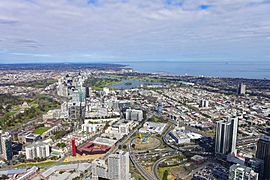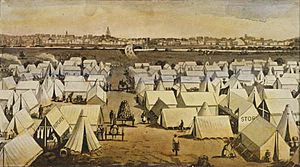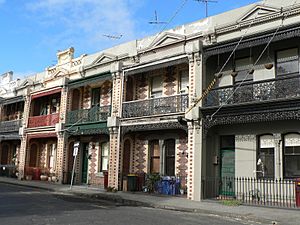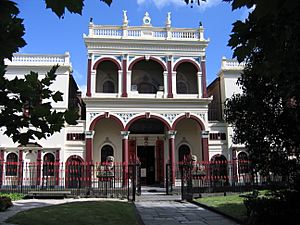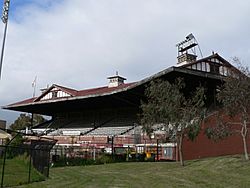South Melbourne, Victoria facts for kids
Quick facts for kids South MelbourneMelbourne, Victoria |
|||||||||||||||
|---|---|---|---|---|---|---|---|---|---|---|---|---|---|---|---|

|
|||||||||||||||
| Population | 10,920 (2016 census) | ||||||||||||||
| • Density | 4,370/km2 (11,300/sq mi) | ||||||||||||||
| Established | 1840s | ||||||||||||||
| Postcode(s) | 3205 | ||||||||||||||
| Elevation | 10 m (33 ft) | ||||||||||||||
| Area | 2.5 km2 (1.0 sq mi) | ||||||||||||||
| Location | 3 km (2 mi) from Melbourne | ||||||||||||||
| LGA(s) | City of Port Phillip | ||||||||||||||
| State electorate(s) | Albert Park | ||||||||||||||
| Federal Division(s) | Macnamara | ||||||||||||||
|
|||||||||||||||
South Melbourne is an inner suburb of Melbourne, Australia, 3 km south of Melbourne's Central Business District (CBD). It is in the local government area of the City of Port Phillip. At the 2016 census, South Melbourne had a population of 10,920.
Historically known as Emerald Hill, it was one of the first of Melbourne's suburbs to adopt full municipal status and is one of Melbourne's oldest suburban areas, notable for its well preserved Victorian era streetscapes.
The current boundaries are complex. Starting at the east end of Dorcas Street, it runs along the rear of properties on St Kilda Road, then south along Albert Road, north up Canterbury Road, along the rear of the north side of St Vincent Place, zigzags west along St Vincent Street, then north up Pickles Street. There is then an arm of former industrial land to the west between Boundary Road, the freeway and Ferrars Street. It then runs along Market Street to Kingsway, then up Dorcas Street to St Kilda Road.
History
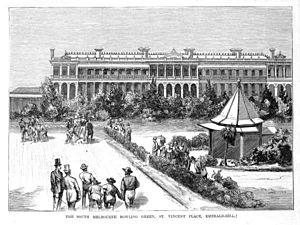
Before European settlement, the area now called South Melbourne featured a single hill (where the Town Hall now stands) surrounded by swamps. The Hill was a traditional social and ceremonial meeting place for Aboriginal tribes.
The area was first settled by Europeans in the 1840s and became known as Emerald Hill.
During the Victorian Gold Rush of 1851 a tent city, known as Canvas Town was established. The area soon became a massive slum, home to tens of thousands of migrants from around the world.
Land sales at Emerald Hill began in 1852 and independence from Melbourne was granted, when Emerald Hill was proclaimed a borough on 26 May 1855. Many of the residents of Canvas Town moved to prefabricated cottages in suburbs like Collingwood and South Melbourne and some of these early homes remain in South Melbourne's Coventry Street.
The new municipality developed rapidly and by 1872 Emerald Hill was proclaimed a town. During the late 1870s, South Melbourne became a favoured place of residents for Melbourne's middle class, with fashionable terraced housing becoming the norm, including some English style squares, the best example of which was St Vincent Gardens. The South Melbourne Town Hall was built between 1879 and 1880 and designed in suitable grandeur to evoke the city's booming status, establishing a civic heart at Bank Street, bordered by Clarendon, Park, Cecil and Dorcas Streets. In 1883 Emerald Hill became a city, changing its official name to South Melbourne.
South Melbourne experienced a decline in the 1950s as Melbourne sprawled outwards. Like many other Melbourne inner city suburbs, during the 1960s, the Housing Commission of Victoria stepped in and erected several high-rise public housing towers, the tallest and largest of which, Park Towers (c.1969) is in South Melbourne. 'Emerald Hill Court' is the other housing commission building located in South Melbourne (c.1962). The result was an injection of migrants adding to the multicultural flavour of the area.
In the 1980s, South Melbourne experienced one of Melbourne's biggest waves of gentrification. in the entire city of Melbourne, attracting many of the residents from the apartment buildings to shop.
Recently, there has been some new developments within South Melbourne and at the Southbank end of Clarendon Street, including Australia's largest hotel.
Transport
South Melbourne is served by tram routes 1, 12, 58, and 96. Route 96 runs along the former St Kilda railway line, which was converted to light rail in 1987.
In 2006 there were strong calls by a joint council project and the Inner Melbourne Action Group to provide an inner south tram link between the City of Port Phillip and the City of Stonnington, by connecting route 112 with route 8 via Park Street. This would have required less than 100 metres of track to be laid along the Park Street gap to create the new route.
Geography
Commercial areas
The main commercial district is centred on Clarendon Street and side streets, including an area around the South Melbourne Market, with many retailers, cafes, eateries and art galleries.
Like the Melbourne CBD, there are many small laneways in South Melbourne, most of them cobbled in bluestone.
Housing
South Melbourne's predominant housing is terraced or semi-detached Victorian.
Park Towers is a notable example of Housing Commission of Victoria hi-rise public housing. There are a number of such towers in parts of South Melbourne, built since the 1960s.
In recent years, South Melbourne has seen an increase in population density, due to apartment development in nearby Southbank, where development has spilled over from the Melbourne CBD. To the east, towards the St Kilda Road complex, are many high rise office buildings.
Heritage
The town hall precinct is home to some of Melbourne's best examples of Victorian architecture.
See Yup Temple is a Chinese temple, built by the See Yup Society in 1856, dating back to the gold rush era.
Sport
South Melbourne FC is regarded as one of Australia's most successful soccer clubs, with four national titles to their name. They currently play in the Victorian Premier League at Lakeside Stadium, a rectangular stadium built on Lake Oval, the former home ground of the South Melbourne Swans. Historically, they have been known as South Melbourne Hellas, a tribute to the migrant Greek founders of the club and traditionally played at Middle Park.
It was once home to the South Melbourne Swans, which played in the Victorian Football League (VFL), which played out of the Lake Oval (now Lakeside Stadium) in nearby Albert Park, before relocating to Sydney in 1982 in a radical move, which eventually spawned the national Australian Football League. More recently a new athletics track and field facility replaced the earlier updated soccer ground however soccer is still present in the centre of the track.
Notable people
Notable people from or who lived in South Melbourne include:
- Ian Gardiner (1943–2008), artist, woodcut printmaker
- Robert MacGregor (1825–1883), politician and headmaster
- John Reid "Gentleman Jack" McGowan (1872–1912), champion boxer
- Herbert Henry "Dally" Messenger (1883–1959), champion rugby footballer
- Russell Mockridge (1928–1958), racing cyclist, Olympic Games gold medallist
- Arthur Ted Powell (1947–present), landscape/cityscape artist and printmaker
- William John Wills (1834–1861), pioneering explorer-surveyor and eponymous member of 'the Burke and Wills expedition'



